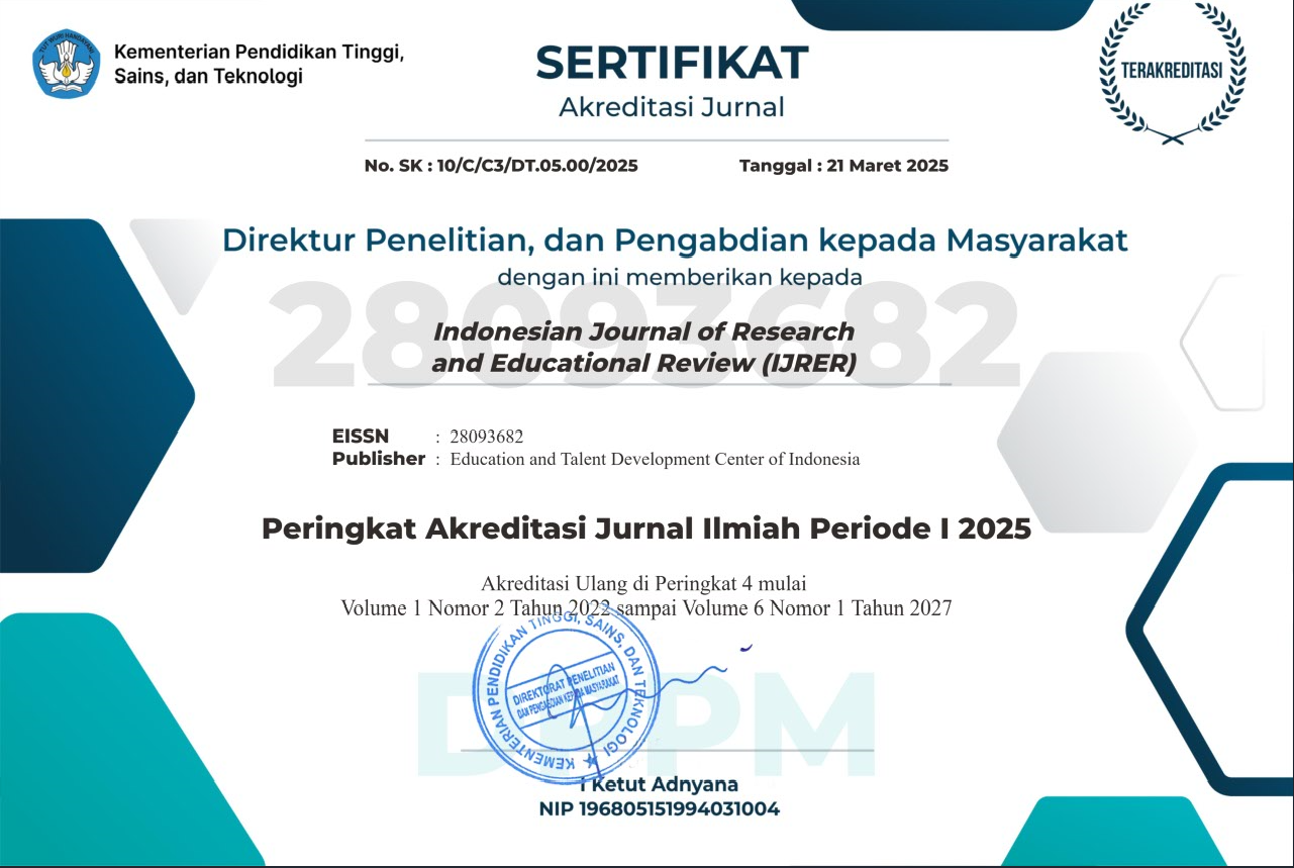Speaking Up with Confidence: Affect Perseverance Theory as Pedagogical Tool at High School
DOI:
https://doi.org/10.51574/ijrer.v4i3.3081Keywords:
High School, Pedagogical Tool, Preseverance Theory, Speaking ConfidenceAbstract
This research investigates the impact of applying perseverance theory on high school students' speaking skills. Specifically, the intent was to enhance students’ oral performance by fostering persistence, reducing anxiety, and encouraging continuous effort in speaking tasks. This type of research is a pre-experimental design, specifically the one-group pre-test and post-test model. We conducted this research at Public High School 20 Gowa. The study focused on first-grade students, with a total sample of 27 participants selected from the overall population. Speaking ability was measured through three main components: accuracy, fluency, and comprehensibility. The results of the study showed that in the pre-test, students showed low average scores—2.33 in accuracy, 2.14 in fluency, and 2.03 in comprehensibility—resulting in a total mean score of 6.59. After implementing perseverance-based teaching strategies, post-test results showed significant improvement: the average score increased to 3.37 in accuracy, 3.07 in fluency, and 2.85 in comprehensibility, with a total mean score of 92.2. These findings suggest that perseverance theory positively influences students’ speaking performance, not only improving technical aspects of language use but also building their confidence and resilience. Therefore, integrating perseverance theory into speaking instruction can be considered an effective approach to support language development in EFL classrooms.
References
Al-Khresheh, M. H. (2024). The role of presentation-based activities in enhancing speaking proficiency among Saudi EFL students: A quasi-experimental study. Acta Psychologica, 243, 104159. https://doi.org/10.1016/j.actpsy.2024.104159
Bi, J., Izadpanah, S., Mohammadi, Z., & Rezaei, Y. M. (2024). Investigating the impact of technology-based education on academic motivation, academic perseverance, and academic self-efficacy in english language learning skills. Education and Information Technologies, 29(15), 20523-20545. https://doi.org/10.1007/s10639-024-12712-0
Bohari, L. (2020). Improving speaking skills through small group discussion at eleventh grade students of SMA Plus Munirul Arifin NW Praya. Journal of Languages and Language Teaching, 7(1), 68-81. https://doi.org/10.33394/jollt.v7i1.1441
Dörnyei, Z., & Henry, A. (2022). Accounting for long-term motivation and sustained motivated learning: Motivational currents, self-concordant vision, and persistence in language learning. In Advances in motivation science (Vol. 9, pp. 89-134). Elsevier. https://doi.org/10.1016/bs.adms.2021.12.003
Feraco, T., Sella, E., Meneghetti, C., & Cona, G. (2023). Adapt, explore, or keep going? The role of adaptability, curiosity, and perseverance in a network of study-related factors and scholastic success. Journal of Intelligence, 11(2), 34. https://doi.org/10.3390/jintelligence11020034
Healey, M. P., & Hodgkinson, G. P. (2024). Overcoming strategic persistence: Effects of multiple scenario analysis on strategic reorientation. Strategic Management Journal, 45(8), 1423-1445. https://doi.org/10.1002/smj.3589
Ismail, H. (2024). Upgrade the Students’ Speaking Ability: Implementation of the Callan Method at the Second Grade Students High School. ETDC: Indonesian Journal of Research and Educational Review, 3(2), 59-69. https://doi.org/10.51574/ijrer.v3i2.1386
Larsen‐Freeman, D. (2018). Looking ahead: Future directions in, and future research into, second language acquisition. Foreign language annals, 51(1), 55-72. https://doi.org/10.1111/flan.12314
Lin, J. (2025). A structural relationship model for L2 oral proficiency, L2 interest, perceived importance of speaking, and out-of-class L2 contact. Language Teaching Research, 29(2), 700-725. https://doi.org/10.1177/13621688221074027
Madjid, M. (2020). Improving speaking skill by using group work method. JLA (Jurnal Lingua Applicata), 3(1), 1-9. https://doi.org/10.22146/jla.50732
Mega, I. R., & Sugiarto, D. (2020). Speaking Skill in Correlation with English Speaking Learning Habit and Self Confidence of Vocational High School Students. Journal of Foreign Languange Teaching and Learning, 5(2). https://doi.org/10.18196/ftl.5253
Nagle, C. (2021). Using Expectancy Value Theory to understand motivation, persistence, and achievement in university‐level foreign language learning. Foreign Language Annals, 54(4), 1238-1256. https://doi.org/10.1111/flan.12569
Nuha, M. U., & Saputri, T. (2021). Improving Students’speaking Skill Through Youtube Video: Systematic Review. Konstruktivisme: Jurnal Pendidikan Dan Pembelajaran, 13(1), 25-36. https://doi.org/10.35457/konstruk.v13i1.1098
Pane, I. I. I., Hutasuhut, M. L., Damanik, S. F., & Haswani, F. (2022). Teachers’ Perception Of 2013 Curriculum Implementation In Junior High School. Language Literacy: Journal of Linguistics, Literature, and Language Teaching, 6(2), 545–559. https://doi.org/10.30743/ll.v6i2.8863
Richards, J. C. (2017). Teaching English through English: Proficiency, pedagogy and performance. RELC Journal, 48(1), 7-30. https://doi.org/10.1177/0033688217690059
Ritonga, M., Febriani, S. R., Kustati, M., Khaef, E., Ritonga, A. W., & Yasmar, R. (2022). Duolingo: An Arabic speaking skills’ learning platform for andragogy education. Education Research International, 2022(1), 7090752. https://doi.org/10.1155/2022/7090752
Sadapotto, A., Syahrir, L., & Hermansyah, S. (2024). An Analysis of the Use of Collaborative Learning Methods in Increasing Students’ Motivation in Learning English. INTERACTION: Jurnal Pendidikan Bahasa, 11(2), 924-935. https://doi.org/10.36232/interactionjournal.v11i2.1192
Saputri, K., Sulistiyo, U., & Abrar, M. (2024). Assessing the Preparedness of English as a Foreign Language (EFL) Teachers in Implementing the 2022 National Curriculum at Senior High Schools. AL-ISHLAH: Jurnal Pendidikan, 16(2), 934–947. https://doi.org/10.35445/alishlah.v16i2.4765
Sindoni, M. G. (2011). Online conversations: A sociolinguistic investigation into young adults’ use of videochats. Classroom Discourse, 2(2), 219-235. https://doi.org/10.1080/19463014.2011.614055
Syahputra, D. S., Azwan Ali, M. Ikhsan Alfasiri, Herdiansyah Putra, & Raja Muhammad Husein. (2023). Public Speaking Training for Youth in Koto Perambahan Village, Kampar Regency in Improving Public Speaking Skills. Al-Arkhabiil: Jurnal Pengabdian Masyarakat, 3(3), 31–41. https://doi.org/10.51590/jpm_assunnah.v3i3.508
Wang, R., Shirvan, M. E., & Taherian, T. (2021). Perseverance of Effort and Consistency of Interest: A Longitudinal Perspective. Frontiers in Psychology, 12. https://doi.org/10.3389/fpsyg.2021.743414
Wu, Y. T., Foong, L. Y. Y., & Alias, N. (2022). Motivation and Grit Affects Undergraduate Students’ English Language Performance. European Journal of Educational Research, 11(2), 781–794. https://doi.org/10.12973/eu-jer.11.2.781
Zhan, L. (2023). Leading with passion, purpose, and perseverance. In The rise of Chinese American leaders in US higher education: Stories and roadmaps (pp. 331-341). Cham: Springer Nature Switzerland. https://doi.org/10.1007/978-3-031-42379-6_28

Downloads
Published
How to Cite
Issue
Section
License
Copyright (c) 2025 Saiful Saiful

This work is licensed under a Creative Commons Attribution-ShareAlike 4.0 International License.













1.png)













